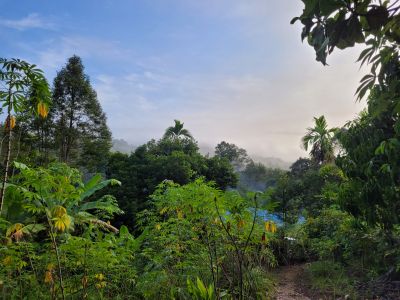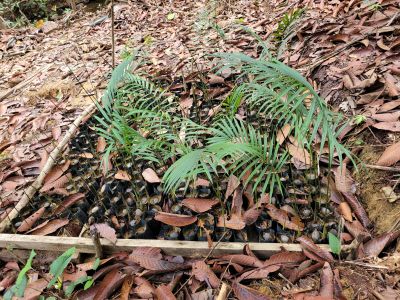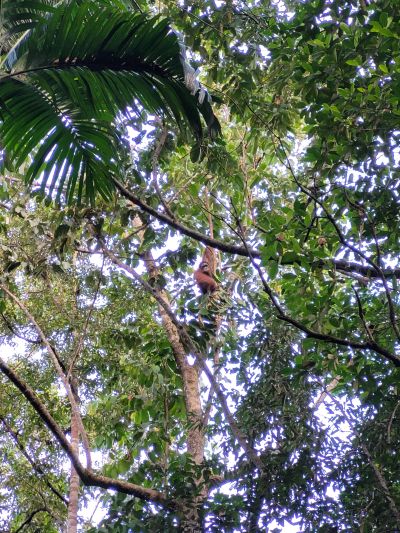Ulu Sungai Menyang
Asia > Malaysia > Ulu Sungai Menyang
Summary
- Northwest Bornean orangutans (Pongo pygmaeus pygmaeus) are present in Ulu Sungai Menyang.
- It has been estimated that 200-270 individuals occur in the site.
- The orangutan population trend is unknown.
- The site has a total size of 430 km².
- Key threats to orangutans are hunting and potential habitat loss due to logging.
- Conservation activities have focused on ecotourism, supporting livelihoods through a gaharu tree project, and supporting orangutans by planting fruit trees and palms that they feed on.
- Indigenous Iban longhouse communities are found in the site, where they have lived for centuries; through their knowledge and customs they have protected orangutans and other wildlife in the area.
Site characteristics
The site is located in the Malaysian state of Sarawak, Borneo. It is situated between Batang Ai National Park, the border to Indonesia, and the Batang Ai lake, which is an artificial lake that was created as a hydroelectric reservoir. The site, which is now classified as a Conservation Area, was proposed as an extension of Batang Ai National park following a 2013 survey that documented a high density of orangutans in the area (Borneo Adventure 2019, Sarawak Tourism).
Table 1. Basic site information for Ulu Sungai Menyang
| Area | 430 km² |
| Coordinates | 1.191402, 111.939060 |
| Designation | Conservation Area |
| Habitat types | Subtropical/tropical moist lowland forest, water storage area, plantations |
IUCN habitat categories Site designations
Ape status
Table 2. Ape population estimates in Ulu Sungai Menyang
| Species | Year | Abundance estimate (95% CI) | Density estimate [ind./ km²] (95% CI) | Encounter rate (nests/km) | Area | Method | Source | Comments | A.P.E.S. database ID |
|---|---|---|---|---|---|---|---|---|---|
| Pongo pygmaeus pygmaeus | 2012-2013 | 115 (57-176) | 0.82 (0.41-1.26) | Ulu Sungai Menyang landscape, 140 km2 | Marked Nest Count | Pandong et al. 2018 | |||
| Pongo pygmaeus pygmaeus | 2023 | 270 | Ulu Sungai Menyang Conservation Area | Guesstimate | Manggat Meringai pers. comm. 2023 | Manggat Meringai is the chief of the Manggat longhouse, located inside the conservation area |
Threats
Logging companies have been stopped by local Iban communities on multiple occasions (Manggat M. pers comm. 2023).
Table 3. Threats to apes in Ulu Sungai Menyang
| Category | Specific threats | Threat level | Quantified severity | Description | Year of threat |
|---|---|---|---|---|---|
| 1. Residential & commercial development | Unknown | ||||
| 2. Agriculture & aquaculture | 2.1 Annual & perennial non-timber crops | Low | Some forest clearing occurs for agriculture, mainly rice cultivation. However, the Ibans allow for the forest to regenerate and the expansion of paddy fields is controlled (Ordaz-Nemeth pers. obs. 2023). | Ongoing (2023) | |
| 3. Energy production & mining | Unknown | ||||
| 4. Transportation & service corridors | Unknown | ||||
| 5. Biological resource use | 5.1 Hunting & collecting terrestrial animals | Present, severity is unknown | Hunters come from outside towns and communities and target different wildlife, including orangutans (Manggat M. pers comm. 2023). | Ongoing (2023) | |
| 6. Human intrusion & disturbance | Unknown | ||||
| 7. Natural system modifications | Unknown | ||||
| 8. Invasive & other problematic species, genes, diseases | Unknown | ||||
| 9. Pollution | Unknown | ||||
| 10. Geological Events | Absent | ||||
| 11. Climate change & severe weather | Unknown | ||||
| 12. Other options | Absent |
Conservation activities
Due to an abundance of feeding trees and protection from the local Iban longhouse communities, the orangutan population in the area is stable. WWF-Malaysia and the Forest Department Sarawak initiated a project in 2014 to support income generation for local communities through the plantation of native gaharu trees in degraded land. Gaharu trees are used for the production of agarwood, but the leaves can also be harvested and used for tea (WWF).
Table 4. Conservation activities in Ulu Sungai Menyang
| Category | Specific activity | Description | Year of activity |
|---|---|---|---|
| 1. Residential & commercial development | Not reported | ||
| 2. Agriculture & aquaculture | Not reported | ||
| 3. Energy production & mining | Not reported | ||
| 4. Transportation & service corridors | Not reported | ||
| 5. Biological resource use | 5.12. Implement local no-hunting community policies/traditional hunting ban | Local Iban communities do not hunt nor consume orangutans (Manggat M. pers comm. 2023). | Ongoing (2023) |
| 6. Human intrusion & disturbance | Not reported | ||
| 7. Natural system modifications | Not reported | ||
| 8. Invasive & other problematic species, genes, diseases | Not reported | ||
| 9. Pollution | Not reported | ||
| 10. Education & Awareness | Not reported | ||
| 11. Habitat Protection | 11.2. Legally protect primate habitat | The site is designated as a Conservation Area. | Ongoing (2023) |
| 12. Species Management | Other | Planting of sago palms and fruit trees for orangutans (Ordaz-Nemeth pers. obs. 2023) | Ongoing (2023) |
| 13. Livelihood; Economic & Other Incentives | Not reported |
Conservation activities list (Junker et al. 2017)
Challenges
Table 5. Challenges reported for Ulu Sungai Menyang
| Challenge | Source |
|---|---|
| Not reported |
Research activities
Documented behaviours
Table 6. Ape behaviors reported for Ulu Sungai Menyang
| Behavior | Source |
|---|---|
| Not reported |
References
Borneo Adventure (2019). 200 orangutan found living outside Batang Ai National Park. Retrieved 15 Sept 2023. Online: https://borneoadventure.com/blog/2013/04/orangutan-survey-menyang/
WWF (n.d.). Planting a future for orangutans and people. Retrieved 15 Sept 2023.Online: https://www.wwf.org.uk/success-stories/planting-future-orangutans-and-people
Page completed by: Isabel Ordaz-Nemeth Date: 15/09/2023



